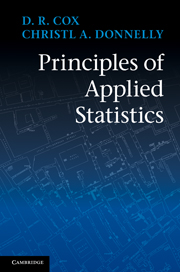3 - Special types of study
Published online by Cambridge University Press: 07 September 2011
Summary
This second chapter on design issues describes the main types of study in more detail. For sampling an explicit population of individuals the importance of a sampling frame is emphasized. Key principles of experimental design are discussed, including the factorial concept. Finally, various types of comparative observational investigation are outlined.
Preliminaries
We now discuss in a little more detail the main types of study listed in Section 2.3. The distinctions between them are important, notably the contrast between observational and experimental investigations. Nevertheless the broad objectives set out in the previous chapter are largely common to all types of study.
The simplest investigations involve the sampling of explicit populations, and we discuss these first. Such methods are widely used by government agencies to estimate population characteristics but the ideas apply much more generally. Thus, sampling techniques are often used within other types of work. For example the quality, rather than quantity, of crops in an agricultural field trial might be assessed partly by chemical analysis of small samples of material taken from each plot or even from a sub-set of plots.
By contrast, the techniques of experimental design are concentrated on achieving secure conclusions, sometimes in relatively complicated situations, but in contexts where the investigator has control over the main features of the system under study. We discuss these as our second theme in this chapter, partly because they provide a basis that should be emulated in observational studies.
- Type
- Chapter
- Information
- Principles of Applied Statistics , pp. 29 - 52Publisher: Cambridge University PressPrint publication year: 2011



